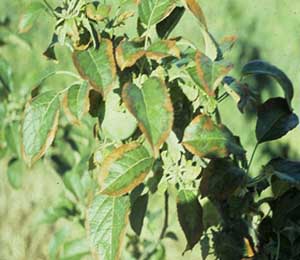Apple (Malus pumila) is commercially the most important temperate fruit and is fourth among the most widely produced fruits in the world after banana, orange and grape. Apple cultivation is suitable in loamy soils with rich in organic matter and pH range of 5.5-6.5. Soil should not have water logging and soil with good drainage is ideal for apple farming. Apple can be grown at altitudes 1,500-2,700 m. above m.s.l. in the Himalayan range which experience 1,000-1,500 hours of chilling (the no. of hours during which temperature remains at or below 70 C during the winter season). Areas exposed to high velocity of winds are not desirable for apple cultivation.

 Deficient apple leaves are pale green to yellow.
Deficient apple leaves are pale green to yellow.
 Color develops uniformly on the leaf with no patterning or mottling, and leaf size is small.
Color develops uniformly on the leaf with no patterning or mottling, and leaf size is small.

 That tissue later turns a bronze color and may eventually die, producing a scorched zone along the edges of leaves as the deficiency progresses.
That tissue later turns a bronze color and may eventually die, producing a scorched zone along the edges of leaves as the deficiency progresses.

 Inadequate Mg causes a yellowing of tissue along leaf margins and between the main veins.
Inadequate Mg causes a yellowing of tissue along leaf margins and between the main veins.
 Symptoms may initially develop along leaf margins, similar to K deficiency symptoms
Symptoms may initially develop along leaf margins, similar to K deficiency symptoms

 Inadequate B results in a reduction in leaf size.
Inadequate B results in a reduction in leaf size.
 New shoot growth is severely reduced, and shoot tips may die back in severe cases.
New shoot growth is severely reduced, and shoot tips may die back in severe cases.

 Symptoms are similar to those of Mg deficiency, but they appear first on young leaves.
Symptoms are similar to those of Mg deficiency, but they appear first on young leaves.
 Youngest leaves yellow between the veins.
Youngest leaves yellow between the veins.

 Leaves are much smaller than normal and narrow.
Leaves are much smaller than normal and narrow.
 The tissue between the main veins turns yellow and chlorotic.
The tissue between the main veins turns yellow and chlorotic.

 Bitter pit associated with localized deficiency of calcium in apple fruit.
Bitter pit associated with localized deficiency of calcium in apple fruit.
 Lesions typically concentrated towards the calix end of fruit.
Lesions typically concentrated towards the calix end of fruit.

 Iron deficient leaves showing bleached appearance on youngest leaves, and necrotic margins
Iron deficient leaves showing bleached appearance on youngest leaves, and necrotic margins